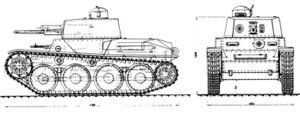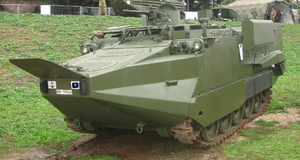Calinthian Military
| Calinthian Armed Forces Calintian: Forze Armate Calintiae | |
|---|---|
| Motto | Marcia e naviga per Dio (March and Sail for God) |
| Founded | 1521. Then later re-founded in 1938. |
| Current form | Military Initiative 1964 |
| Disbanded | 1861. |
| Service branches | |
| Headquarters | Aurelia, Calinthia |
| Leadership | |
| Grand General | Syrilla Constatine II |
| Chief of Defence | General of the Military Felicio Franz Sarino |
| Manpower | |
| Military age | 18 |
| Conscription | Yes, mandatory for males. Females may serve in non-combat roles. |
| Active personnel | 1,481,638 military & 219,274 civilian (2018) |
| Reserve personnel | At any time, 2,000,000 reservists can be called upon |
| Industry | |
| Domestic suppliers | YERA • MAX • DRD |
| Foreign suppliers | |
| Related articles | |
| History | Military history of Calinthia |
| Ranks | Ranks and insignia of the Calinthian Armed Forces |
The Calinthian Armed Forces is the military of the Kingdom of Calinthia.
History

The history of the Calinthian military dates back to 1521 AD, when King Joraine I decreed the creation of the Kingdom of Calinthia. The Calinithian military participated in many wars dating from 1521 AD up until its dissolution in 1861. In 1861, the creation of the Republic of Calinthia saw the reformation of the military. While the societal militarism that had become prevalent in the 1700s was still intact, many policies were passed to "de-radicalize" and to reduce loyalty to the crown within the military. Such laws like the Blood of the Republic Law of 1891 were passed to achieve this. These laws and policies saw many military career soldiers and officers pushed out of the military by force, regardless of military experience. This is now believed by modern Calinthian scholars to have greatly reduced the fighting capabilities of the Calinthian Military during the Great War. After having lost upwards of 1 million soldiers in the Great War, many Republican reformations were undertaken. Several-hundred military officers that were pushed out of the military were inducted back into positions of power, regardless of the Blood of the Republic Law of 1891. This created a situation in which Loyalist military officers were in charge of Republican soldiers.

Over the next two decades, riots, protests, and military demonstrations would see the Republican military deployed around Calinthia. The most famous of these incidents is the Christmas Civil War of 1931. While only lasting a single week, this conflict saw Republican military units assaulting positions of the Loyalist 138th Calinthian Guard Division in the city of Milanopolis on the 21st of December. The result of the battle was 6,264 Republican soldiers killed, and 4,069 Loyalist soldiers killed, as well as the surrender of the 138th Calinthian Guard Division. This sparked public outrage at the Republican guard for having gone straight to violence against Loyalists, and refusing to negotiate. It wasn't until 1936 that the Republican military would face a much larger split in forces when Republican General Juna Ricola would take half of the military and a majority of the Navy and join the Loyalist cause. For two years the Calinthian Civil War would rage, resulting in the dissolution of the Republic of Calinthia, and it's military. For six years the Calinthian Civil War would rage.
Furthering the issues of the Republic was the Communist uprisings on the Western territories of Calinthia by mainly Gothic Calinthians. At first the Communist Calinthians and Loyalist Calinthians would openly fight one another in many minor skirmishes in the North. However, by late 1937 the Communist Calinthians under General Secretary of the Communist Party Siegmund Goering would ally themselves with the Loyalists against the Republican Guard Forces. With Communist forces in the West and Loyalists in the East, the Republican Guard quickly found themselves on the back-foot. By early 1940, Republican Guard Forces prepared a hastily built defense around Aurelia and struggled to maintain their supply lines from the port of Napolis. Constant air attacks by the superior Loyalist air force rendered many of the railroads inoperable. In addition, the mechanized Communist assaults using a tactic called "Schwerpunkt" penetrated deep into Republican Guard lines, cutting supply lines. The tactic was an adaptation of the Urcean "lightning war" tactic developed by Benno de Caryale. It was adapted and implemented by the Calinthian People's Army under the command of General Friedrich von Guder, a graduate of the Urcean Imperial War College and student of de Caryale's tactics.
The Calinthian Civil War resulted in the dissolution of the Republic of Calinthia and it's military in 1942. Following the collapse of the Republic of Calinthia, Gothic Calinthians formalized their new state through the creation of the Soviet State of Calinthia (SSC). The Monarchic Loyalists had declared their statehood much earlier during the war in 1938 with the coronation of King Rudolph Constatine II. With the Loyalists now once more in control of the military, the Loyalist government set about large military reformations. Any Republican sentiment in the military was outlawed, and any still loyal to the Republican government were exiled or imprisoned. This included Republican General Licoa Miduci who was exiled to Ardmore in 1941 after being imprisoned since 1938. Radical indoctrination programs were also implemented in the military and even education system. These programs would teach the value of Catholicism, as well as strength of Absolute Monarchy. Pictures of the Constatine monarch Randolph III were commonplace going forward in both military and education installations following his coronation in 1946. In addition, military hardware and technology were improved upon post Second Great War. A new uniform known as the M-41 Kit was handed out to represent the renewed loyalty to the Constatine family. The M-41 Kit also known as the Montuoso-41 Kit was the first step in standardizing Loyalist military forces.
Command structure
Organization
Tactics & Strategy

Since the Military Initiative 1964, Calinthian ground tactics consist of large mechanized and armoured assaults with supporting artillery using the Calinthian strategy of 'Defense Maneuver'. In Defense Maneuver, Calinthian forces dig entrenched forward positions in such a way that they can easily fall back while under the cover of other nearby friendly positions. When Calinthian armed forces go on the offensive, they do so slowly and methodically, building entrenchments, forward operating bases, and solidifying logistical lines. In addition, a strong reliance on tanks, mobile infantry, as well as mass artillery mean that no unit has a high likelihood of being unsupported at any given time. However, in exchange for survivability and time, Calinthian armed forces relinquish land, and fortified positions. This means most Calinthian ground forces choose to retreat to better positions rather than stay and fight to the death. Most Calinthian equipment represents this strategy and preference of long range engagements.







Equipment
All numbers are approximate and as per the Calinthian Armed Forces' own statistics
| Equipment | Numbers | Notes |
|---|---|---|
| Main Battle Tanks | 3,102 | 1,261 in storage |
| Infantry Fighting Vehicles | 9,811 | 3,000 in storage (mostly outdated models) |
| Utility Vehicles | 2,900 | 411 in storage |
| Trucks | 1,611 | Estimated 400 in storage |
| Towed Artillery | 3,968 | TBD |
| MLRS | 638 | 61 in storage, 40 in production as of 2022 |
| Fighter Aircraft | 200 | 112 in storage |
| Bomber Aircraft | 634 | Naval use only; 300 in storage |
| Transport Helicopters | 189 | Most are AMS-68 taken from the Calinthian People's Army |
| Attack Helicopters | 123 | Most are AMS-72 taken from the Calinthian People's Army |
| Destroyers | 31 | 26 in storage, with 11 more in production |
| Carriers | 12 | 4 in production |
| Submarines | 61 | 12 in storage |
| Hospital and Logistical ships | 200 | 23 in storage |
| Cruisers | 121 | 11 in storage |
| Amphibious Assault Vehicles | 6,112 | 736 in storage (mostly Joraine MK II) |
Gallery
-
A side view of a Joraine MK I
-
Artist rendition of the standardized Calinthian M-62 Kit adopted in the early 1960s.
-
A 1944 MAX Mobilo MK I.
-
A blue-print of the Galaecius MK I from 1934.
-
An early Galaecius MK III in a factory (1959).
-
The DRD Aleric MK I Anti-Air platform. An AA version of the Galaecius MK III tank.
-
An Aleric MK I AA platform in use during training in 1984.
-
A de-commissioned Joraine MK II outside the Aurelia History Museum.
Notes
The Air Force is directly tied to the Navy, and thus the Air branch of the Military does not exist on its own.







